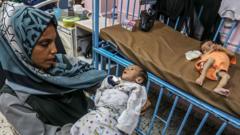Despite claims from Israel denying the existence of a siege and blaming Hamas for the crisis, international organizations warn of mass starvation and implore for unhindered humanitarian aid access.
In an alarming report by the UN’s Palestinian refugee agency, known as Unrwa, it has been revealed that one in five children in Gaza City is suffering from malnutrition, and the condition is deteriorating on a daily basis. Commissioner-General Philippe Lazzarini expressed the grim reality in Gaza, with a colleague stating, "People in Gaza are neither dead nor alive; they are walking corpses."
Support from over 100 global aid and human rights organizations has emerged, sounding the alarm for what they describe as an impending mass starvation crisis and calling on governments to respond urgently. Israel, however, refutes the claims of a siege, attributing the malnourishment to Hamas’s actions, while the UN asserts that the current level of aid entering Gaza is only a "trickle," with warnings that the hunger crisis has reached unprecedented levels.
Lazzarini's statement underscored the alarming statistics that "more than 100 people, mostly children, have reportedly died of hunger." He stressed that many children exhibiting severe malnourishment are at an immediate risk of death without essential treatment. He further urged Israel to facilitate the passage of unrestricted humanitarian assistance into Gaza.
The World Health Organization (WHO) has echoed these concerns, highlighting that a substantial portion of Gaza’s population is facing starvation, with WHO Director-General Tedros Adhanom Ghebreyesus decrying the crisis as “man-made.”
Accounts from aid workers like Tahani Shehada illustrate the dire conditions; she described her baby’s inability to taste fresh fruits and the struggles faced by families searching for food. Locals often find empty markets or exorbitantly priced goods. One mother, Hanaa Almadhoun, relayed her experience with people resorting to selling personal items just to afford basic sustenance.
Despite Israel’s assurances to provide humanitarian assistance in accordance with international law, reports indicate that aid deliveries have faced severe disruptions and danger. A doctor in Gaza confirmed their current state as living through famine as individuals risk their lives for limited aid, with many casualties reported by the UN as over 1,000 Palestinians have been killed near aid distribution points.
Palestinians, like 19-year-old Najah seeking refuge in a hospital, express fears of being shot while trying to reach aid distribution sites— where many others have been killed. Many residents, including women expecting children, plead for survival in dire conditions where even basic necessities have become luxuries.
As fear and despair grow within the stricken population, appeals continue for intervention to alleviate the humanitarian disaster facing Gaza, raising questions about the future prospects for its people in an ongoing conflict.
In an alarming report by the UN’s Palestinian refugee agency, known as Unrwa, it has been revealed that one in five children in Gaza City is suffering from malnutrition, and the condition is deteriorating on a daily basis. Commissioner-General Philippe Lazzarini expressed the grim reality in Gaza, with a colleague stating, "People in Gaza are neither dead nor alive; they are walking corpses."
Support from over 100 global aid and human rights organizations has emerged, sounding the alarm for what they describe as an impending mass starvation crisis and calling on governments to respond urgently. Israel, however, refutes the claims of a siege, attributing the malnourishment to Hamas’s actions, while the UN asserts that the current level of aid entering Gaza is only a "trickle," with warnings that the hunger crisis has reached unprecedented levels.
Lazzarini's statement underscored the alarming statistics that "more than 100 people, mostly children, have reportedly died of hunger." He stressed that many children exhibiting severe malnourishment are at an immediate risk of death without essential treatment. He further urged Israel to facilitate the passage of unrestricted humanitarian assistance into Gaza.
The World Health Organization (WHO) has echoed these concerns, highlighting that a substantial portion of Gaza’s population is facing starvation, with WHO Director-General Tedros Adhanom Ghebreyesus decrying the crisis as “man-made.”
Accounts from aid workers like Tahani Shehada illustrate the dire conditions; she described her baby’s inability to taste fresh fruits and the struggles faced by families searching for food. Locals often find empty markets or exorbitantly priced goods. One mother, Hanaa Almadhoun, relayed her experience with people resorting to selling personal items just to afford basic sustenance.
Despite Israel’s assurances to provide humanitarian assistance in accordance with international law, reports indicate that aid deliveries have faced severe disruptions and danger. A doctor in Gaza confirmed their current state as living through famine as individuals risk their lives for limited aid, with many casualties reported by the UN as over 1,000 Palestinians have been killed near aid distribution points.
Palestinians, like 19-year-old Najah seeking refuge in a hospital, express fears of being shot while trying to reach aid distribution sites— where many others have been killed. Many residents, including women expecting children, plead for survival in dire conditions where even basic necessities have become luxuries.
As fear and despair grow within the stricken population, appeals continue for intervention to alleviate the humanitarian disaster facing Gaza, raising questions about the future prospects for its people in an ongoing conflict.



















